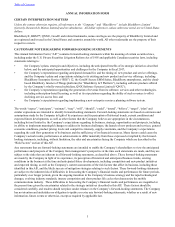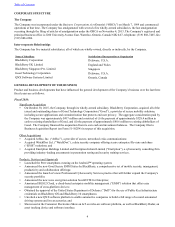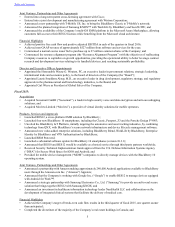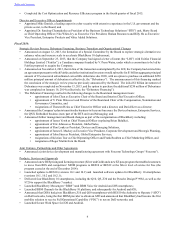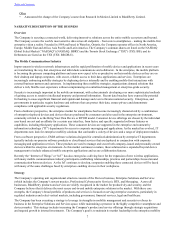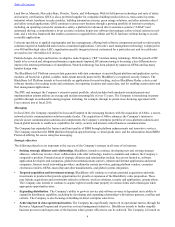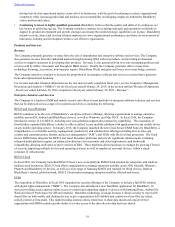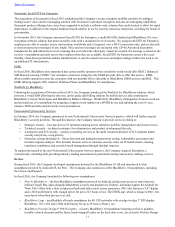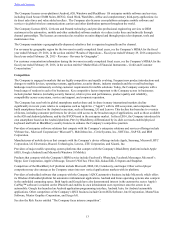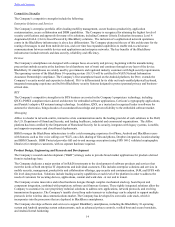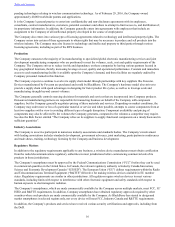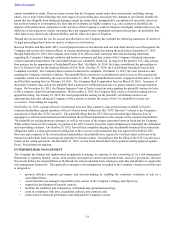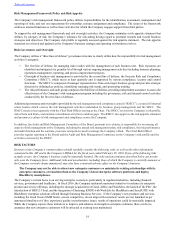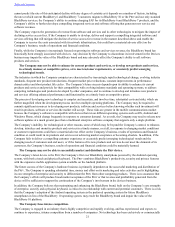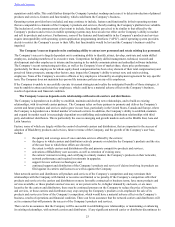Blackberry 2016 Annual Report Download - page 22
Download and view the complete annual report
Please find page 22 of the 2016 Blackberry annual report below. You can navigate through the pages in the report by either clicking on the pages listed below, or by using the keyword search tool below to find specific information within the annual report.
Table of Contents
13
The Company licenses cross-platform (Android, iOS, Windows and BlackBerry 10) enterprise mobile software and services,
including Good Secure EMM Suites, BES12, Good Work, WatchDox, AtHoc and complementary third-party applications via
its direct sales force and value added resellers. The Company also licenses cross-platform enterprise mobile software and
services via global wireless communications carriers and other distribution partners throughout the world.
The Company licenses QNX, Certicom and Paratek technology and provides professional engineering services to OEM
customers in the automotive, mobile and other embedded software markets via a direct sales force and indirectly through
channel partnerships. The licenses are monetized as royalties on units shipped and through project development, tools and
maintenance fees.
The Company maintains a geographically-dispersed salesforce that is organized regionally and by channel.
For revenues by geographic region for the two most recently completed fiscal years, see the Company’s MD&A for the fiscal
year ended February 29, 2016, in the section entitled “Results of Operations - Fiscal year ended February 29, 2016 compared to
fiscal year ended February 28, 2015 - Revenue - Revenue by Geography”.
For customer concentration information during the two most recently completed fiscal years, see the Company’s MD&A for the
fiscal year ended February 29, 2016, in the section entitled “Market Risk of Financial Instruments - Credit and Customer
Concentration.”
Competition
The Company is engaged in markets that are highly competitive and rapidly evolving. Frequent new product introductions and
changes to mobile devices, operating systems, applications, security threats, industry standards and the overall technology
landscape result in continuously evolving customer requirements for mobile solutions. Today, the Company competes with a
broad range of vendors in each of its businesses. Key competitive factors important to the Company across its businesses
include product features (including security features), relative price and performance, product quality and reliability,
compatibility across ecosystems, service and support, and corporate reputation.
The Company has seen both its global smartphone market share and its share in many international markets decline
significantly in recent years relative to companies such as Apple Inc. (“Apple”) with its iOS ecosystem, and companies that
build smartphones based on the Android ecosystem, such as Samsung, LG and Lenovo. This decline has been due to a variety
of factors, including consumer preferences for devices with access to the broadest range of applications, such as those available
in the iOS and Android platforms, and by the BYOD trend in the enterprise market. In fiscal 2016, the Company introduced its
own smartphone based on the Android platform, PRIV by BlackBerry, differentiated by its slide out touch-enabled physical
keyboard and built-in BlackBerry security features to enhance the Company’s competitive position.
Providers of enterprise software solutions that compete with the Company’s enterprise solutions and services offerings include
VMware Inc., Microsoft Corporation (“Microsoft”), MobileIron Inc., Citrix Systems, Inc., SOTI Inc., SAP SE, and IBM
Corporation.
Manufacturers of mobile devices that compete with the Company’s device offerings include Apple, Samsung, Microsoft, HTC
Corporation, LG Electronics, Huawei Technologies, Lenovo, ZTE Corporation, and Xiaomi, Inc.
Providers of major mobile operating system platforms that compete with the Company’s BlackBerry platform include Apple
(iOS), Google (Android) and Microsoft (Windows 10 Mobile).
Products that compete with the Company’s BBM service include Facebook’s WhatsApp, Facebook Messenger, Microsoft’s
Skype, Line Corporation, Apple’s iMessage, Tencent’s WeChat, Viber, Kik, KakaoTalk, Telegram and Snapchat.
Competitors of the BlackBerry IoT platform include Microsoft, IBM, GE, Cumulocity, and Jasper. Other vertical player
competitors may also emerge as the Company enters into new vertical applications markets with its platform.
Providers of embedded software that compete with the Company’s QNX automotive business include Microsoft, which offers
its Windows Embedded platform for automotive infotainment applications. Android and Linux operating systems also compete
in the embedded computing space. Both Apple and Google have also demonstrated interest in the automotive sector. Apple’s
CarPlay™ software is resident on the iPhone® and enables its own infotainment user experience onto the screen in an
automobile. Google has launched an Android application programming interface, Android Auto, for Android automobile
applications. Other competitors of the Company’s QNX business include Green Hills Software, Intel Corporation, MontaVista
Software, Mentor Graphics Corporation, and Sysgo AG.
See also the Risk Factor entitled “The Company faces intense competition”.


